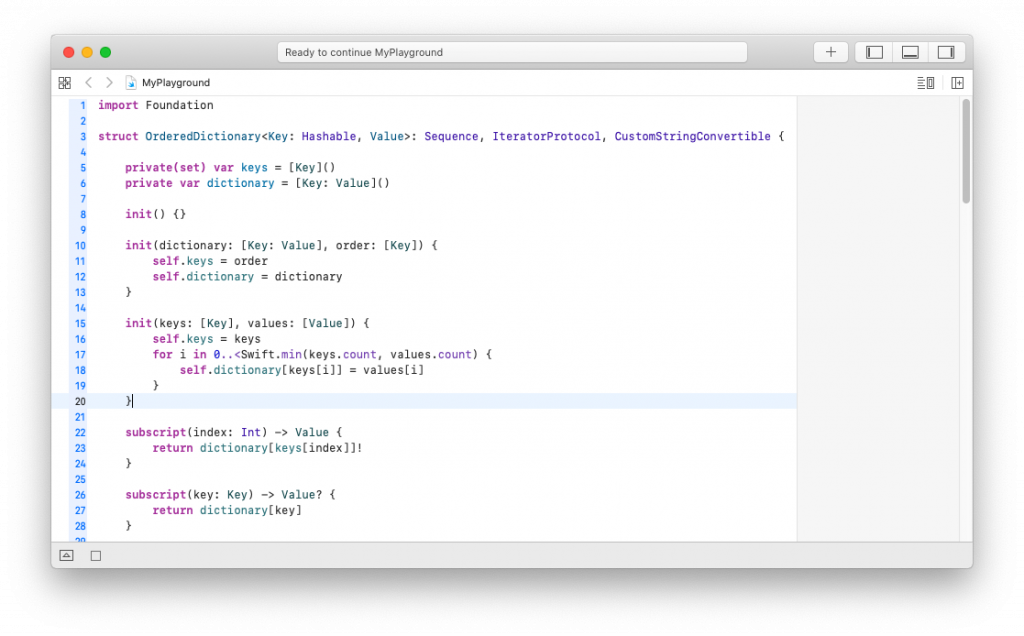[Swift]Dictionaryに順番を持たせたい

SwiftのDictionaryはハッシュを用いるので、値をイテレータで取り出すと順番がバラバラになって出てきます。
今回、Dictionaryに入れた要素がArrayのように並んでいる、そんなデータ構造が欲しかったので作った話です。
ゴール
var orderedDictionary = OrderedDictionary(keys: ["foo", "bar"], values: ["hoge", "fuga"])
orderedDictionary["foo"] // -> "hoge"
orderedDictionary[1] // -> "fuga"このようにアクセスできること、あと別途メソッドを用意して要素の追加/挿入/削除を行えるようにします。
コード
実際に構造体を作っていきます
基本形
struct OrderedDictionary<Key: Hashable, Value>: Sequence, IteratorProtocol, CustomStringConvertible {
private(set) var keys = [Key]()
private var values = [Key: Value]()
}まんま、DictionaryとArrayを両方含んだ構成になります。ちなみに、上記のコードだと通常のDictionaryに加えて、Keyの順番をArrayで保持しています。
initializer
init() {}
init(dictionary: [Key: Value], order: [Key]) {
self.keys = order
self.values = dictionary
}
init(keys: [Key], values: [Value]) {
self.keys = keys
for i in 0..<Swift.min(keys.count, values.count) {
self.values[keys[i]] = values[i]
}
}引数に合わせて変数に格納していきます。
subscript
変数名[Index or Key]で要素にアクセスできるようにします
subscript(index: Int) -> Value {
return dictionary[keys[index]]!
}
subscript(key: Key) -> Value? {
return dictionary[key]
}properties
主によく使うものだけ
var count: Int {
return keys.count
}
var values: [Value] {
return keys.compactMap({ dictionary[$0] })
}
var first: (key: Key, value: Value)? {
if count > 0 { return (keys[0], self[0]) }
return nil
}
var last: (key: Key, value: Value)? {
if count > 0 { return (keys[count - 1], self[count - 1]) }
return nil
}
var description: String {
if keys.count < 1 { return "[:]" }
let str = keys.reduce("", { "($0), ($1): (dictionary[$1]!)"})
return "[" + str[str.index(str.startIndex, offsetBy: 2)...] + "]"
}keysは基本形にあるstored propertyが使えるので必要ない。
操作
値の追加/挿入/削除を行うメソッドです
mutating func append(_ value: Value, for key: Key) {
keys.append(key)
dictionary[key] = value
}
mutating func insert(_ value: Value, for key: Key, at index: Int) {
keys.insert(key, at: index)
dictionary[key] = value
}
@discardableResult
mutating func remove(at index: Int) -> (key: Key, value: Value) {
let key = keys.remove(at: index)
defer {
dictionary[key] = nil
}
return (key, dictionary[key]!)
}
@discardableResult
mutating func remove(for key: Key) -> Value? {
if let index = keys.firstIndex(of: key) {
return remove(at: index).value
}
return nil
}検索
func firstIndex(where predicate: ((key: Key, value: Value)) throws -> Bool) rethrows -> Int {
for (i, key) in keys.enumerated() {
if try predicate((key, dictionary[key]!)) { return i }
}
return -1
}普段firstIndexしか使わないので、とりあえずこれだけ。
と言ってもfirst(where:)やlastIndex(where:)もほぼ同じ感じで書けるので問題ないかと。
イテレータ
for (key, value) in 変数名という形でループできるようにします
var iteratorCount = 0
mutating func makeIterator() -> OrderedDictionary<Key, Value> {
iteratorCount = 0
return self
}
mutating func next() -> (key: Key, value: Value)? {
defer { iteratorCount += 1 }
return iteratorCount < count ? (keys[iteratorCount], self[iteratorCount]) : nil
}SequenceとIteratorProtocolに適応している必要があります
これで実用可能な程度には実装ができたと思います。
コード全体
Ordered Dictionary in Swift. GitHub Gist: instantly share code, notes, and snippets.
追記
同じkeyの値を代入した場合
var orderedDictionary = OrderedDictionary<String, String>()
orderedDictionary.append("hoge", for: "foo")
orderedDictionary.append("fuga", for: "foo")
orderedDictionary // -> [foo: fuga, foo: fuga]あくまでKeyの順番を配列で保持しているだけなので、同じKeyに値を代入すると最初の値が後の値に上書きされます。
以下のように配列にValueを格納し、DictionaryにIndexを格納するようにすれば後の値で上書きされずにIndexを指定して最初の値を取り出すことができますが、その場合insertやremoveの際にDictionaryを更新する手間が増えるのと、僕の用途では重複したKeyを指定して両方取り出したい場面がなかったので、こっちの実装にしました。
private(set) var values = [Value]()
private var indexes = [Key: Int]()
mutating func insert(_ value: Value, for key: Key, at index: Int) {
values.insert(value, at: index)
indexes = indexes.mapValues({ $0 >= index ? $0 + 1 : $0 })
indexes[key] = index
}気に入っている実装
自分で作ったオブジェクトを格納するだけなら、オブジェクトにString型のプロパティを用意してそれをキーに使用すれば、Keyを別途与えなくても配列と同じように操作できる。
protocol OrderedDictionaryItem {
var id: String { get set }
}
struct OrderedDictionary<T: OrderedDictionaryItem>: Sequence, IteratorProtocol {
private var ids = [String]()
private var items = [String: T]()
// 省略
}汎用性は下がるが、アプリ内で保存しているデータを管理するならこっちの方が便利。
コメント